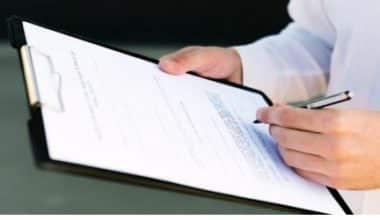Depending on the nature and location of your business, you may be required to maintain liability insurance. General liability insurance protects your business against accidental property and bodily injury claims. It also includes reputational damage, advertising damage, and copyright infringement. If your company is required to have liability insurance, you may be asked to provide a liability insurance certificate. But even if you are not required to carry this coverage, a general liability insurance certificate can help allay client worries. This article will explain what a certificate of liability insurance is, how to get it, the cost, an example, and the Acord certificate of liability insurance.
Certificate of Liability Insurance
Insurance companies and brokers are the ones who issue certificates of insurance (COIs). The certificate of insurance (COI) acknowledges the existence of an insurance policy and specifies its principal characteristics and terms. A normal COI, for example, includes the policyholder’s name, the policy’s effective date, the kind of coverage, policy limits, and other relevant policy facts.
Without a COI, a company or contractor may have difficulties recruiting clients since they will likely be unwilling to take the risk of any expenditures that the contractor or provider may incur.
When you get into talks with another party, one of the first questions you may be asked is whether or not you are insured. Before signing a client contract, commercial lease, or operating as a contractor, you will frequently need to provide proof of insurance. This ensures that you are insured for any accidents that may occur while executing your duties and that anyone you are working with or for is not required to reimburse the damages or deal with lawsuits. A certificate of insurance is the simplest approach to demonstrate your coverage and assuage your partner’s anxieties. Your insurance provider can generate the certificate and deliver it to you or whoever is demanding proof of your insurance at no additional cost.
What Is a Certificate of Liability Insurance
A certificate of liability insurance is proof that you have general liability insurance. It is also known as a certificate of general liability insurance, confirmation of insurance, or an ACORD 25 form. This document contains information about:
- Coverage limits and maximums
- Your insurance provider
- The named insured on the policy
- Policy effective date
To obtain a certificate of liability insurance, you must purchase a policy of general liability insurance. After the policy is issued, your liability insurance certificate will be accessible online.
General liability insurance, sometimes called commercial general liability insurance or business liability insurance, provides crucial protection against legal claims made against your company. It assists in covering claims that your business caused bodily injury or property damage to a third party. It can also help cover claims of bodily injury, libel, and slander against your business.
Why Might I Need a Certificate of General Liability Insurance?
Small business owners may require a certificate of liability insurance for a variety of reasons, including:
A client: Before agreeing to deal with your company, a customer will want to ensure that you have the necessary insurance coverages to complete the project in the event of a claim.
Your landlord: If you rent office space for your business, your landlord may require that you obtain professional liability insurance to cover business-related claims.
Professional licenses required: Some professionals, such as real estate brokers, are required to hold general liability insurance.
How Certificates of Insurance (COI) Work
Certificates of insurance (COIs) are utilized in most business contexts where liability and significant losses are a concern and a COI is required. A certificate of insurance is a document that proves insurance coverage.
Small business owners and contractors frequently have a COI that confirms they have liability insurance for workplace accidents or injuries. The insurance company will normally give an insurance certificate when you purchase liability insurance.
Without a COI, a business owner or contractor may struggle to get contracts. Because many businesses and individuals engage contractors, the client needs to know that a business owner or contractor carries liability insurance so that they will not be held liable if the contractor is responsible for damage, injury, or poor workmanship.
#1. Validating an Insurance Certificate
A client would typically request a certificate from the insurance company rather than the business owner or contractor. The client should double-check that the name of the insured on the certificate matches the company or contractor they are considering.
In addition, the client should examine the insurance coverage dates to ensure that the policy’s effective date is accurate. If the policy is slated to expire before the contractual service is completed, the client should obtain a new certificate.
#2. Details of an Insurance Certificate
General, auto, umbrella, and workers’ compensation liability coverage are all specified separately on certificates of insurance. The term “insured” refers to the policyholder, person, or corporation listed on the certificate as being insured.z
In addition to the coverage levels, the certificate provides the policyholder’s name, postal address, and a description of the procedures performed by the insured. The address of the issuing insurance firm is mentioned, as well as contact information for the insurance agent or
contact person at the insurance agency. If more than one insurance company is involved, their names and contact details are included.
A client becomes a certificate holder when they seek a COI. In the bottom left-hand corner, the client’s name and contact details appear, along with statements indicating the insurer’s obligation to notify the client about policy cancellations.
The certificate summarizes the insured’s policies and the coverage limitations offered for each type of coverage. The general liability section, for example, explains the six limits offered by the policy by category and indicates whether coverage applies per claim or per occurrence. Workers’ compensation coverage will have no limit because state regulations govern the benefits granted to injured workers. However, the limits of an employer’s liability coverage should be specified.
Read Also: HISCOX BUSINESS INSURANCE REVIEW 2023
Certificate of Liability Insurance Cost
In general, existing customers receive free certificates of liability insurance from business insurance providers.
To gain access to a certificate of liability insurance, you must obtain a policy, and the cost of business insurance can vary greatly based on what your company does, how many employees you have, if you’ve filed claims in the past, and other considerations. Obtaining estimates from multiple insurance providers will assist you in locating the finest coverage at the best price.
How to Get a Certificate of Liability Insurance
There are a few important steps to take in order to get a Certificate of Liability Insurance for your company.
#1. Get the Necessary Information
The first step in acquiring a COI is to inquire about the hiring company’s minimal coverage needs. In practice, this means requesting a formal statement of the liability coverages and limits that your company must have in order to win the job or lease the property. This information will be required by your agent or insurer in order to issue the COI.
#2. Contract Your Agent, Broker, or Insurer
Inform either of these parties that you require a COI. If you are unsure whether your current insurance fits the standards, consult with your insurance professional. If your current policy does not match the standards, ask your agent or insurer what adjustments will be required and how much they will cost.
Assume a prospective landlord demands a $2 million general aggregate maximum on your liability policy. If your policy’s aggregate maximum is currently $1 million, your insurance agent should discuss the expense of additional limitations. When all of the necessary adjustments have been made, request that your agent or insurer issue the certificate.
Read Also: FREELANCE INSURANCE: Everything You Should Know
Certificate of Liability Insurance Acord
You can verify your liability insurance coverage with an ACORD 25 Certificate of Liability Insurance. When you get commercial liability coverage, you will receive a certificate of insurance.
Certificates of insurance (COI), also known as ACORD 25 forms, are one-page documents that demonstrate to contracting parties that you carry the required business liability coverage. Holding an insurance certificate demonstrates to clients and suppliers that your company has adequate coverage against standard risks.
Your insurance company would gladly give you a certificate of liability insurance upon request. Your policy or policies’ coverage categories, insurance policy numbers, policy limits (including per-occurrence and aggregate limits), effective date, and expiration date are all summarized here.
A single-page document, known as an ACORD certificate of liability insurance, can verify to contracting parties that you carry the necessary business liability insurance.
In addition to the insurance company’s phone number, certificate number, contact person, postal address, and fax number, a liability insurance certificate may include wording relevant to the terms, exclusions, and conditions of the policy.
The terms of insurance policies are subject to variation. Insurance companies issue certificates of liability insurance for a variety of small-business insurance plans, such as
- Commercial general liability (CGL) insurance
- Business owner’s policy (BOP)
- Commercial auto insurance
- Professional liability insurance, often known as errors and omissions insurance (E&O), protects businesses from lawsuits.
- Workers’ compensation insurance
- Commercial umbrella insurance
Certificate of Liability Insurance Example
There are nine parts to a COI that list the business owner’s insurance plans, their limits, the name of the insurance company, and other important information. Understanding the information provided within a COI is almost as crucial as having the certificate itself. Here’s an example of an extract from a certificate of liability insurance:
- Disclaimer: A statement clarifying the COI and the intended use of information
- Producer: The insurance firm, broker, or agent who represents the insured.
- Insured: The named individual or entity listed on the insurance
- Insurance firms that provide coverage: The insurance firms that offer the coverage stated in the COI.
- Coverages: descriptions of specific policies purchased by the insured.
- Description of Operations, Locations, and Vehicles: Detailed information about the business’s elements
- Certificate Holder: The individual or company to whom the certificate is granted.
- Cancellation: An explanation of the insurance company’s cancellation notification procedures
- Authorized Representative: The insurance firm, agent, or broker authorized to sign the certificate
This is an example from the nine sections of the certificate of liability insurance.
What Is the Acord Certificate?
An ACORD certificate verifies that you have the amount and type of liability insurance required by the customer for the project. A bank or mortgage business may also require an ACORD certificate for a property on which they have a mortgage, or an equipment leasing company when leasing equipment for a project.
What Is Acord Used For?
ACORD (Association for Cooperative Operations Research and Development) is the international standards-setting organization for the insurance and associated financial services industries.
What Is the Latest Version of Acord 25?
You should rely on the creators of the forms, ACORD, to locate the most current and up-to-date ACORD 25 form. Go to their website and look for the forms portal. There, you should be able to find the most recent version of the ACORD 25 form.
How Do I Get a Certificate of Insurance for Acord?
- Through your agent, get a certificate of general liability insurance.
- To request insurance certificates, go to My Account on our website. Most requests are handled immediately.
What Is Acord 35?
This form is used for policy cancellation requests, often known as a Lost Policy Release (or LPR). Please see our playlist for more ACORD form tutorial videos. We’ll make as many as our viewers and insurance colleagues request.
What Is the Difference Between Cancellation and Policy Release?
Canceling an insurance policy used to entail returning the paper policy packet to the insurance company. Cancellation in the modern insurance sector does not necessitate mailing back the policy. In most circumstances, lost policy releases are thus unnecessary.
How Do I Request To Cancel My Insurance?
The first step is to call your insurance company. Notify them of your intention to cancel. Most likely, you will be asked to write down your plans to stop at this point. Even if your insurance does not require a cancellation letter, it is a good idea to send one so that you have a record of your request.






